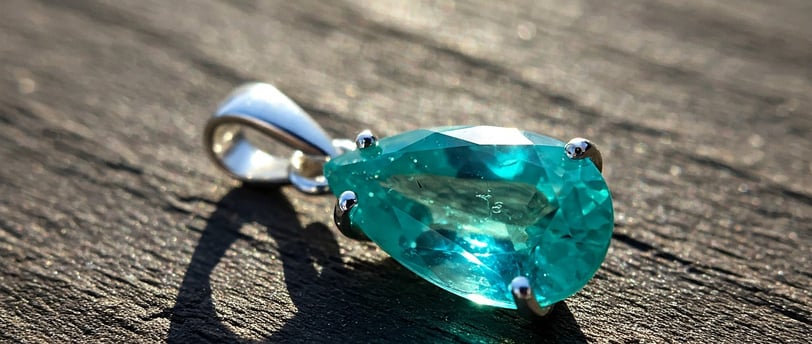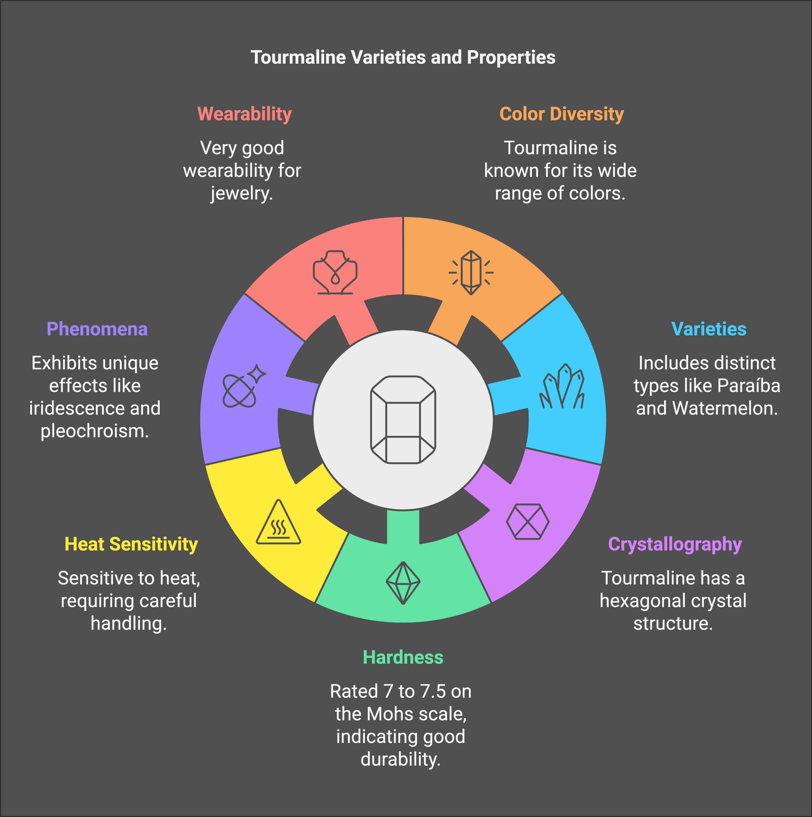Tourmaline
Tourmaline is known for its stunning, saturated hues and is a colourful and modern gemstone. It comes in an amazing range of colours, including multi-colour zones, making it a very popular choice for jewellery.
1/30/20254 min read


History
Tourmaline, a gemstone with a captivating history, was once known by the Sinhalese name "turamali," meaning "stones with mixed colors". This name arose because any stone that wasn't a ruby or sapphire was simply called a "turmali". It wasn't until the gemological boom of the 1970s that tourmaline gained widespread recognition as a distinct gemstone. Before then, tourmaline was often mistaken for other gems, including zircons, fancy sapphires, beryls, chrysoberyls, feldspars, and garnets. Today, tourmaline is celebrated for its vibrant colors and is a popular choice for jewelry. The first recorded discovery of a green tourmaline crystal was in 1554, when Francisco Spinoza’s expedition found what they called a "Brazilian emerald".
Mineral Origins
Tourmaline is not just one mineral, but rather a group of related minerals with varying chemical compositions and properties. All tourmalines share a trigonal (hexagonal) crystal structure, but their chemical formulas differ significantly. This chemical complexity is responsible for the wide array of colors and color patterns found in tourmalines. The most common tourmaline species used in jewelry is elbaite, but other species such as dravite, liddicoatite, schorl, and uvite are also used. Tourmalines are found worldwide, with significant sources in Brazil, the United States, and Nigeria. In the early 1900s, Maine and California were major producers of gem tourmalines. California is known for pink tourmaline, while Maine is known for sherbet-colored and mint green tourmalines. Brazil currently produces the largest volume of tourmaline, with the widest color variety.
The 4 C’s
Color
Tourmaline is famous for its diverse range of colors, which span the entire spectrum. The most valued tourmalines are those with bright, pure tones of red, blue, and green. However, the electric vivid green to blue shades of copper-bearing tourmaline, known as Paraíba tourmaline, are considered exceptional and command a premium. Rubellites are pink to red tourmalines often compared to rubies and pink sapphires. Indicolites are blue tourmalines, and chrome tourmalines are a distinct grassy green due to the presence of chromium. Verdelite is the name for green tourmalines that do not have chromium or vanadium. Some tourmalines also exhibit multiple colors within a single stone, known as bi-color or parti-color tourmalines. Watermelon tourmalines are unique with a pink core and a green outer layer. The saturation and tone of the color are also important factors; highly saturated colors without dark areas are most valuable.
Clarity
Tourmalines often form in environments rich in liquids, which can lead to inclusions. These inclusions are typically thread-like cavities that run parallel to the length of the crystal. When cut as cabochons, these inclusions may produce a cat's-eye effect. Clarity expectations differ by color; green tourmalines are expected to be eye-clean, while red and watermelon tourmalines often have visible inclusions. Eye-clean indicolites and paraíba tourmalines are rare and highly valued. Inclusions that reach the surface can affect the stone's luster and are less desirable.
Carat
Tourmalines are available in various sizes, but larger sizes, especially in fine colors, are rare and command higher per-carat prices. Verdelites and rubellites are readily available up to six carats, with anything over 15 carats being rare. Chrome tourmalines tend to be smaller, with most under two carats and those over eight carats being rare. Indicolite of any size is rare. Paraíba tourmalines from Brazil are also rare, typically under two carats, but those from Mozambique can be much larger, up to 20 carats.
Cut
The elongated shape of tourmaline crystals often results in long, narrow cuts, but cutters also consider the depth of color when orienting the gem. The cut is crucial for maximizing a gem's beauty and brilliance. A poorly cut gem will be less marketable. To darken a pale stone, cutters orient the table perpendicular to the crystal's length, and to lighten a dark stone, they orient the table parallel to the crystal's length. The pleochroic nature of tourmaline, where it shows different colors in different crystal directions, is often taken into account by skilled lapidaries.
Be Aware Of
Enhancements
Most tourmalines undergo heat treatment to enhance their color. Radiation treatment is also common, particularly for pink, red, and blue tourmalines. These treatments usually produce stable colors. Green tourmalines are sometimes heated to lighten their color. Vendors often do not disclose these treatments, so it is important to ask about any enhancements before purchasing. Some tourmalines may also have acid treatments to bleach dark inclusions, and plastic or epoxy fillers to seal hollow tubes.
Simulants
Although there are no commercially available synthetic tourmalines, other materials such as dyed quartz, glass, or lab-created stones like synthetic spinel are sometimes used as simulants. It is important to be aware of these imitations and to seek clarification if a stone is presented as a "synthetic tourmaline".
Synthetics
Synthetic tourmalines are difficult and expensive to manufacture. While scientists have produced synthetic tourmalines for research purposes, there are no commercially available synthetic tourmalines for gem or jewelry use. Some rumors have surfaced about synthetic tourmalines entering the market, but these have been largely discredited.
Final Thoughts
Buying Tips
When buying tourmaline, view it under different types of lighting, as colors may shift or become less saturated in incandescent light. Always ask about any treatments the stone may have undergone. If purchasing a paraíba tourmaline, it is recommended to have it tested to verify its origin. Be aware of misleading terms, such as "Brazilian emerald" or "Ceylonese peridot," as these may be used to sell tourmalines at higher prices.
Jewelry Care
Tourmaline is a durable gemstone with a hardness of 7 to 7.5 on the Mohs scale, making it suitable for everyday wear. However, it is important to avoid cleaning tourmaline jewelry with ultrasonic or steam devices, as the vibrations and heat can cause liquid inclusions to expand and shatter the stone. Instead, clean tourmaline jewelry with a soft brush, mild detergent, and warm water. Tourmaline's electrical conductivity means it can attract more dust than other stones, so more frequent cleaning may be needed. Also be aware that color changes caused by irradiation can fade with exposure to heat or bright light.


Gemius Stones
Expertise
© 2025. All rights reserved.
